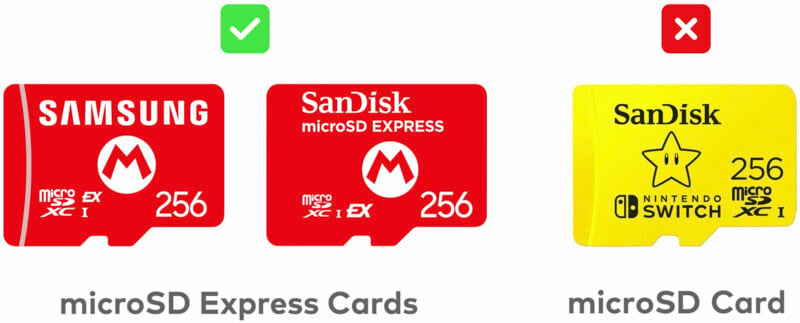SD Express Finally Has a Use, But It Dumped Its Biggest ‘Advantage’
![]()
SD Express, a format that has been completely ignored by the camera industry, finally has a use case. In today’s Nintendo Direct, the company said the new Switch 2 would make use of microSD Express for the faster transfer speeds. Unfortunately, it dumps the biggest “advantage” originally touted by the SD Association: backward compatibility.
During the hour-long online presentation, Nintendo spent a few seconds talking about the new storage format for its upcoming video game console (time-stamped in the embed below).
“Switch 2 will only work with microSD Express cards. They’re a different type of SD card and will make high-speed data transfers possible,” it explained.
The latest update to the SD Express specification allows the cards to read and write data significantly faster than standard SD cards do. When cards have a rounded box with a large “E” on the left, the following number would promise 150, 300, 450, or 600 MB/s minimum transfer speeds. If one doesn’t appear, the assumption is that it will at least be faster than standard SD, which typically caps out below 100 MB/s write speeds.
However, what will very likely cause a lot of confusion with Switch customers upgrading to Switch 2 will be that the memory cards they’ve been using for the last several years won’t work at all in Switch 2.
“Please note that regular microSD card used for Nintendo Switch will not be compatible,” the company says.

Even though SD and SD Express were designed to have some manner of backward compatibility, it was never complete. Because SD Express changes how the contacts on the cards work with the switch to PCIe, it can’t use them both with the protocols designed for standard SD. As such, while SD Express is backward compatible with standard SD, it will only ever be so at UHS-I speeds — a fact PetaPixel has pointed out multiple times.
SD Express only ever made more sense than CFexpress because the form factor was familiar. Without that, the format is slower and has more limitations on capacity than any of the three CFexpress form factors.
That is, except in this case — and it might be the only argument where SD Express makes some sense. Nintendo chose to go the route of the microSD form factor, which is much smaller than any CFexpress card can get. But in a choice that will absolutely cause confusion among the average consumer, the company chose to completely forgo backward compatibility. Now in order to get additional storage on the Switch 2, consumers will have to buy brand new memory cards, which is basically the entire reason folks didn’t want to jump to CFexpress if they didn’t have to and held out hope SD Express would save the day.
Samsung announced a 1TB microSD express card last year but pricing wasn’t mentioned and the company still doesn’t list any on its website and nothing comes up when searching the site for “SD express.” Given that the headline image for the Switch 2 SD Express is a Samsung card, this will surely change soon. In the meantime, Lexar announced compatible cards today for the Switch 2 that start at $100 for 512GB and go up to $200 for 1TB. Considering standard microSD cards have been dirt cheap for years now, many will likely come up against serious sticker shock when the cheapest Lexar card they can use costs almost a quarter the price of the console.
Image credits: Nintendo